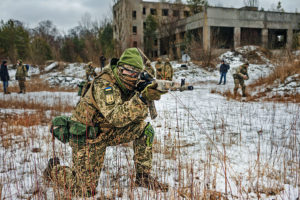Russia’s loyal oligarchs have always been liable to become chess pieces in political struggles. After the revolution broke out in Petrograd in February 1917, the long-despised Romanov aristocracy were ruthlessly stripped of their property and most prized possessions. The people demanded nothing less than their total humiliation and dispossession.
One by one all the vast palaces of the aristocracy were “expropriated” — a favourite word of the revolution — and systematically vandalised and looted. Their lavish interiors were trashed, paintings slashed, priceless Aubusson carpets ruined, antique furniture broken up for firewood and famous wine cellars pillaged in an orgy of drinking and violence. Even Lenin was seen driving around the city in one of Nicholas II’s prized Delaunay-Belleville limousines.
What a contrast this was to the last gilded, heady days of the Belle Epoque, when the old tsarist oligarchs had indulged themselves in the food, fine wines, casinos and high-class courtesans of Paris. Before the war, couples such as the Grand Duke Paul Alexandrovich and his wife Olga had a swanky home in the Bois de Boulogne, where they entertained the glitterati of Marcel Proust’s Paris. At Madame Yturbe’s Hungarian costume ball in 1912, Olga arrived dripping in luxury — in a dress by Worth encrusted with rows of pearls and a Cartier tiara of pear-shaped diamonds.
The legendary wealth of the Russian elite was perhaps epitomised by the fabulous jewellery they purchased in St Petersburg from the leading imperial jeweller and master goldsmith, Carl Fabergé. The high point of Romanov extravagance was manifested in the fabulous, ornately jewelled Easter eggs that Fabergé produced for the Imperial Family between 1886 and 1916 — some 54 eggs in all, of which 44 survive today.
Fifteen of those eggs form the centrepiece of the current exhibition “Fabergé: Romance to Revolution” at the V&A. Of the 233 charming works of art in the show, 13 are on loan from Russian institutions, causing some to question whether they will now be caught up in the new “cultural Cold War”. Will they be returned to Russia while hostilities continue? Already, the UK government has sanctioned the billionaire Viktor Vekselberg, whose foundation loaned the golden “Hen egg” for the exhibition.
Coming as it does during this dramatic conflict between Ukraine and Russia, and an accompanying outburst of virulent Russophobia in the West, the Fabergé exhibition cannot help but provide a mournful and telling parallel of what happens to wealth and privilege when they are dispossessed and routed.
In 1917, along with many other private businesses, Carl Fabergé’s was seized and taken over by a workers’ collective. He found it hard to adjust and a year later fled Russia when the Bolsheviks nationalised his company. With German assistance he got out of Petrograd under diplomatic protection and made his way to Lausanne in Switzerland where he died in 1920, heartbroken that the glittering life he had once known “is no more”.
Meanwhile many of his patrons left during the 1919–20 mass exodus south out of Russia — through today’s war-torn Ukraine — to Odessa and Novorossisk when General Wrangel’s White Army took its last stand against the Red Army. At that time, a million Russians fled into Europe — but that figure is today dwarfed by the number of refugees escaping Ukraine.
Today’s Russian oligarchs — the new post-Soviet aristocracy — now find the screws being tightened on them, just as they were on the Romanovs. More and more demands are being made for their property to be sanctioned as punishment for Putin’s war against Ukraine. For after many years of rumbling criticism, the war has finally drawn the world’s attention to the obscene wealth that this elite group of expatriates have enjoyed for far too long. Given their links to Putin, the seizure of their property, in the eyes of many, is a necessary — if not righteous — penalty for their leader’s sins.
Recently, Levelling-Up Secretary Michael Gove suggested that perhaps the mansions of today’s Russian oligarchs should be seized and filled with Ukrainian refugees — as “the ultimate payback for Putin’s cronies”. No sooner said than billionaire industrialist Oleg Deripaska’s lavish mansion in Belgravia was occupied, albeit briefly, by anarchist protesters.
One cannot help but be reminded of a moving scene in David Lean’s film Dr Zhivago, based on Boris Pasternak’s novel, where revolutionaries turn up at the large apartment of the comfortably off Gromyko family of Zhivago’s wife Tonya and announce that their home is forfeit. It is now to become a communal dwelling that the Gromykos will have to share with several workers’ families.
While today’s Russian oligarchs are long practised in every possible tax scam and evasion to hide their wealth from possible confiscation, back in 1917, there was no way that the old aristocracy could evade the cudgel of revolutionary retribution. All they could do was grab a few of their most precious and easily portable possessions, travelling into exile with little more than the clothes they stood in, with their few remaining jewels sewn into their garments.
For Russian refugees, these family heirlooms would be the currency of exile, the only tradable possessions they had left with which to sustain themselves in their future severely reduced lives. Or so they thought. The trouble was that their jewellery had greatly depreciated in value. This was due to a flood of such goods on the European market at the end of the war. For the Russians were not the only aristocracy to have seen their monarchy crash and be forced into selling off their jewels — the German and Austro-Hungarian thrones had gone the same way too.
Only one aristocrat of note, Grand Duchess Vladimir, saw her jewels safely smuggled out of her grand palace in St Petersburg – to London, by a British art dealer and unofficial spy named Bertie Stopford. But her fabulous collection, that had once been the envy of all Paris, was sold off after her death in 1920 to sustain her children in exile. Her magnificent diamond and emerald tiara by court jeweller Carl Edvard Bolin was bought by Queen Mary in 1922 and is a favourite piece worn by our own Queen Elizabeth.
As the Russian old guard fled their homeland they settled into communities of exiles in Berlin, Paris, London and elsewhere. Reduced to poverty, made worse by a lack of skills or any kind of training that would find them jobs, they discovered that the jewels they thought would last them for many years soon ran out. One émigré, Grand Duke Alexander, noted with despair how the proceeds from the sale of his wife Xenia’s great strings of Romanov pearls had lasted just three years. In London, Russian exiles sold their Fabergé treasures for a song at antiques dealers such as Wartski’s in Old Bond Street.
But at least these communities of exiles had each other and could share in the experience of dispossession and poverty. Where will today’s despised Russian oligarchs end up if they continue to support Putin’s pariah regime? Already, many have fled to Dubai in the United Arab Emirates, a financial haven where their wealth can ensure some kind of dismal but comfortable purdah. Their other option, of course, is to leave all their foreign assets behind, and return to Russia — retreating behind the new ‘iron curtain’ that is rapidly descending on their homeland.
Disclaimer
Some of the posts we share are controversial and we do not necessarily agree with them in the whole extend. Sometimes we agree with the content or part of it but we do not agree with the narration or language. Nevertheless we find them somehow interesting, valuable and/or informative or we share them, because we strongly believe in freedom of speech, free press and journalism. We strongly encourage you to have a critical approach to all the content, do your own research and analysis to build your own opinion.
We would be glad to have your feedback.
Source: UnHerd Read the original article here: https://unherd.com



